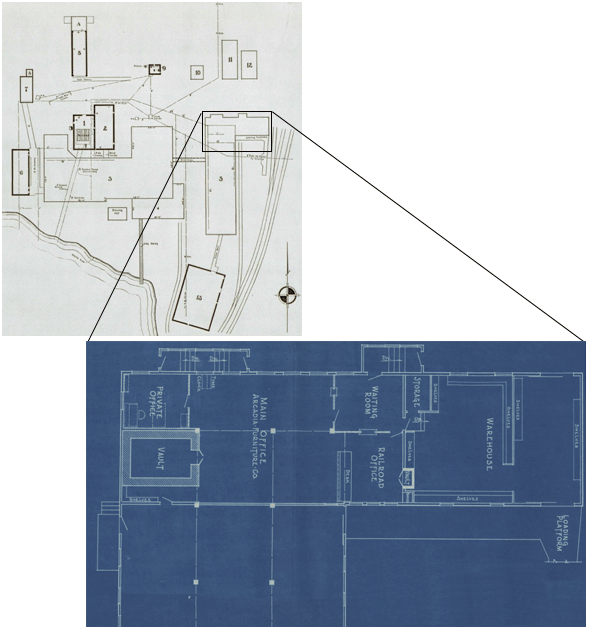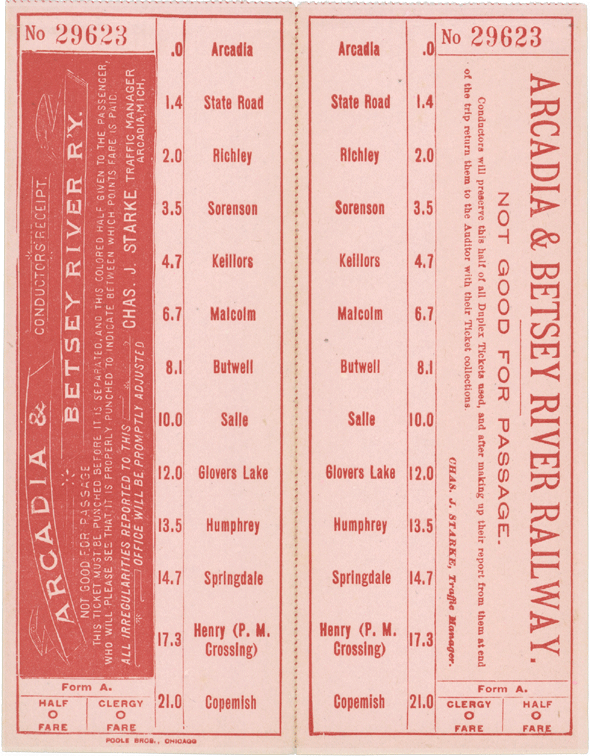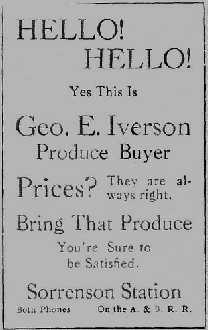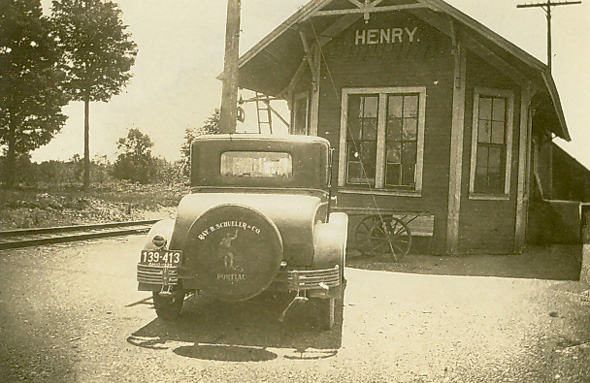Key Stops along the Way
Next | Previous | Return to Start
|
|
This exhibit includes what we know about a few of those stops: Arcadia: Sorenson: Malcolm: Saile: Henry: Copemish: |
Arcadia: The Start of the LineAt the west end of Lake Street was the Company Store and the Arcadia Furniture Factory. A rail ran between the Factory and the Company Store next to a station waiting room at the east end of the factory. |
|
|
|
|
|
|
|

|
|
Sorenson: Vegetable Processing |
|
|
|
|
|
In the late 1800s, Byron Burmeister bought produce from farmers in northern Michigan and shipped it to market in Chicago and Milwaukee. After 1893 he sold his schooner and began shipping by rail to eastern markets. Shortly after 1900, Burmeister was operating buying stations at eight points along the Manistee and North Eastern Railroad and the Arcadia and Betsy River Railroad. Sorenson was one of those buying stations. |
|
Excerpts from an interview with Mary Alice Grossnickle"The Sorenson Station was an important place in the lives of the Iversons. The Charles Iverson family lived directly across the road in a house owned by Fred Sorenson, the son of A. Sorenson, an early settler of the area. The train making its daily run provided many opportunities for fun and excitement. Children placed pennies and pins on the tracks and listened for that familiar whistle as it neared the station. Both parents were employed by George E. Iverson at different seasons, as the produce was brought in by farmers and growers for sorting, culling, and packing for shipment by rail to mostly eastern parts. Preparing Beans "Early on, potatoes were key, but by 1910 beans began to take the place of potatoes. The varieties were mainly white navy beans and light and dark red kidney beans. A small elevator was built at the Sorenson Station, and cleaning and hand-picking machines were installed. As many as six women were employed to pick out the cull beans and prepare beans for sale. "Located at the top floor of the elevator was the room where the beans were picked. Several women were employed cleaning the culls from the beans. This was called "picking." It was a warm and cozy room with a small wood burning stove. As many as six women worked here at times. The Green Warehouse "The green warehouse at Sorenson Station was built for storing potatoes before shipment. Part of the building was used to preserve ice for summer use. The ice was cut from Bear Lake and hauled by team and sleighs to the station. Aunt Clara Iverson often prepared ice cream using the winter ice and a hand operated freezer. Family members fondly remember this special treat served at summer picnics. In later years the lumber from the green warehouse was used in the construction of cousin Elaine Hensen's house on Norconk road. Business Trips on the Train "My father, George Iverson, sometimes went on a business trip on the A&BRR making connection with another rail line at Copemish or Henry. A story is told as follows: George's home was about a quarter mile from a railroad crossing. Dick Lang, the train engineer, was very accommodating when sometimes George was late. He waited patiently with the engine and cars at the crossing while my father came running with collar and tie in hand. The Steam Log Loader "The steam log loader was often seen on the siding at Sorenson Station, its long boom reminding us of an accident that occurred in earlier years. During the loading of logs on a flat bed car, the boom hit the electric lines which ran near the tracks. The operator was named Cal Dunke, and he lost an arm as a result of the accident. [John W. Martin, who met Calvin Dunke, remembers that Cal actually both arms at the elbows.] ... George Hovis, a farmer resident of Arcadia, tells of helping Cal fill the bowl of his pipe after the accident." |
|
|
The End of an Era "After 1920 George Iverson bought the Sorenson Station from the Burmeister family, and he continued the produce business until 1933. Cherry orchards replaced general farming, and an era had passed. The railroad was discontinued, the road was torn up, and the station was finally abandoned in 1937." |
|
Malcolm"Malcolm Station played a major role in the lives of people living in Pleasanton Township. A passenger train made two round trips daily between Arcadia and Copemish -- one in the morning and one in the evening -- to provide passenger, mail, and express service to Malcolm and the other stations on the line. Freight and logging trains made unscheduled but frequent runs." |
|
|
|
|
|
"Malcolm received shipments of farm machinery, furniture, coal, rock salt, animal feed, and numerous other items. Annual ongoing shipments consisted of several cars each of livestock, salted pickles, potatoes, beans, grain, hay, sugar beets, and apples. During the cooler months Malcolm shipped cream to Blue Valley Creamery of Grand Rapids. Each participating farmer had identical five gallon cream cans that were either going to or coming from the Creamery by way of railway express." Building the Station "Mr. Burmeister, merchant and buyer of farm produce, erected buildings at Saile, Sorenson, and Malcolm to take advantage of the freight service offered by the new carrier. At Malcolm, he built... " The potato warehouse was erected just west of the highway with a freight dock adjacent to the sidetrack. The opposite side had a covered receiving dock, pit scales, and a scale house equipped with a phone that was part of the railway's telephone system. " The second warehouse stood immediately to the west of the potato warehouse. It was served by the sidetrack and was use for the storage of beans, grain, and feedstock sold to farmers. " A holding pen for livestock was west of the second warehouse. The pen consisted of an area enclosed by a board fence and a wood chute, elevated to door height at the sidetrack, used in transferring livestock from the pen to the cattle cars. " The Glacer-Crandall pickle station occupied an area south of the driveway that ran next to the two warehouses. The raised receiving platform had a roof that was continuous with the roof of a building containing an office and a large rock salt storage bin. Elevated runways with a removable section across the driveway were used in removing shipments of rock salt from boxcars and loading salted pickles into tanks mounted on special railcars." Sawlog Storage "A parcel of land lying east of the road at Malcolm Station, taken from the David Green farm, was used to store sawlogs. Local farmers used the winter months to fill the yard with quality hardwood logs. Along the Railway's right-of-way there were enough yards like Malcolm's, along with logging from lands owned by the Starke Land and Lumber Company, to keep a log train busy many days of the year. The logging train consisted of a locomotive, steam powered loading crane with a swinging boom, and several skeletonized cars." Nearby General Store and Post Office "Henry D. Farnsworth, born in 1844, owned and operated a small general store and Post Office at Malcolm. A widower, Mr. Farnsworth had living quarters within the store and was the acting postmaster. The combination store and post office had daily visits by those who spent many hours around the wood burning stove for discussion and argument of timely issues. Isabelle Keilor Anderson possessed a stamp envelope with the cancellation "Malcolm, Michigan." Management "George Iverson, an agent for Mr. Burmeister, supervised business operations at stations located on the Arcadia and Betsey River Railway. From 1923 until the railroad ceased operations at about 1936, Frank G. Martin served as an agent at Malcolm Station. "Charles Eggart managed the warehouses and the pickle station from 1903 until his death in 1922. He owned and lived on a small farm located but a short distance west of the Station. During part of his management, he was assisted by Thomas Snyder, a disabled veteran of the Civil War with a wooden stump for the lower part of one leg. "After Charles Eggart's death, Lawrence Farnsworth took over management of the pickle receiving and storage facilities. Frank G. Martin was the last manager when the facility closed." Handling Potatoes "In the fall and spring, farmers used their horse drawn wagons to deliver potatoes to the station Using a hand powered grader, the potatoes were sorted into two grades: US Number One and others. "The farmer was issued a check based on the total weight of the U.S. Number One potatoes. Because there was little or no market for other potatoes that did not meet the Number One grade, farmers had to find other uses for them. "U.S. Number One grade potatoes went directly from the grader into burlap bags marked with a logo and capable of holding 150 pounds. (Later 100 pound bags were used.) Upon leaving the platform scales, the top of each bag was sewn shut leaving two ears of burlap. The bagged potatoes were either stacked in the warehouse or placed directly into a boxcar spotted opposite the warehouse door. "A filled boxcar would have numerous rows of bagged potatoes stacked across the long dimension of the car, and each row would be at least six feet high. It was no small task to hoist a 150 pound sack to the top of the stack." Saile: Another Burmeister/Iverson Station |
|
|
|
|
Henry: Connections to Other RailroadsBy September of 1895, the A&BRR extended 17.5 miles to Henry, where it connected with the Chicago and West Michigan Railway. Named after Henry, Starke, this stop was the first place where the Arcadia & Betsey River Railway connected with other railroads and the rest of the world. |
|
|
|
|
| In addition to the station, Henry Starke built a sawmill nearby, and a small town grew with homes, a post office, a school, 3 stores, a hotel, and a large hall used for roller skating and dancing. | |
|
|
1903 Map Showing Henry's Strategic Location The blue box shows the location of the station at Henry where three railroads met: the Arcadia & Betsey River Railway from the west, the Pere Marquette running north and south, and the Manistee & North Eastern. -- 1903 plat map of Springdale Township in Manistee County Michigan |
Copemish: Still More ConnectionsBy December of 1896, the A&BRR reached Copemish, where it connected with the Ann Arbor Railroad. At that point, passenger service was added, and the A&BRR might have interchanged with the Bear Lake & Eastern Railroad at Springdale between Henry and Copemish. |
|
|
|
|
|
|
|



 Sorenson Station in winter about 1918
Sorenson Station in winter about 1918







